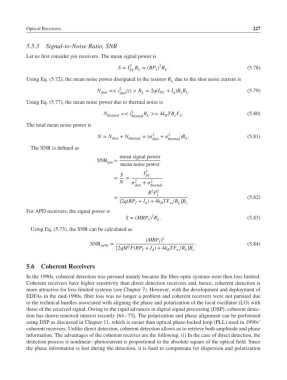Page 246 - Fiber Optic Communications Fund
P. 246
Optical Receivers 227
5.5.3 Signal-to-Noise Ratio, SNR
Let us first consider pin receivers. The mean signal power is
2
2
S = I R =(RP ) R . (5.78)
PC L I L
Using Eq. (5.72), the mean noise power dissipated in the resistor R due to the shot noise current is
L
N =< i 2 (t) > R = 2q(I + I )B R . (5.79)
shot shot L PC d e L
Using Eq. (5.77), the mean noise power due to thermal noise is
N =< i 2 R >= 4k TB F . (5.80)
thermal thermal L B e n
The total mean noise power is
N = N + N =( 2 + 2 )R . (5.81)
shot thermal shot thermal L
The SNR is defined as
mean signal power
SNR =
pin
mean noise power
S I 2 PC
= =
N 2 + 2
shot thermal
2 2
R P I
= . (5.82)
[2q(RP + I )+ 4k TF ∕R ]B e
I
B
L
n
d
For APD receivers, the signal power is
2
S =(MRP ) R . (5.83)
I L
Using Eq. (5.73), the SNR can be calculated as
(MRP ) 2
I
SNR = . (5.84)
APD 2
[2qM F(RP + I )+ 4k TF ∕R ]B e
L
n
B
d
I
5.6 Coherent Receivers
In the 1990s, coherent detection was pursued mainly because the fiber-optic systems were then loss limited.
Coherent receivers have higher sensitivity than direct detection receivers and, hence, coherent detection is
more attractive for loss-limited systems (see Chapter 7). However, with the development and deployment of
EDFAs in the mid-1990s, fiber loss was no longer a problem and coherent receivers were not pursued due
to the technical hurdles associated with aligning the phase and polarization of the local oscillator (LO) with
those of the received signal. Owing to the rapid advances in digital signal processing (DSP), coherent detec-
tion has drawn renewed interest recently [64–73]. The polarization and phase alignment can be performed
using DSP as discussed in Chapter 11, which is easier than optical phase-locked loop (PLL) used in 1990s’
coherent receivers. Unlike direct detection, coherent detection allows us to retrieve both amplitude and phase
information. The advantages of the coherent receiver are the following. (i) In the case of direct detection, the
detection process is nonlinear–photocurrent is proportional to the absolute square of the optical field. Since
the phase information is lost during the detection, it is hard to compensate for dispersion and polarization

